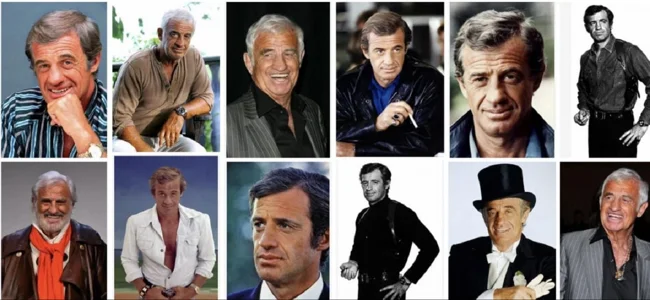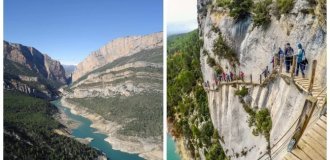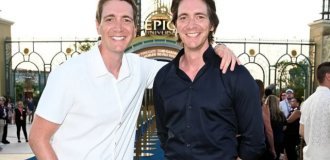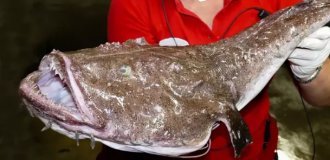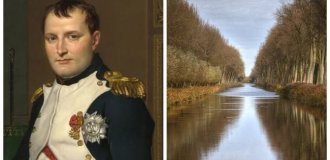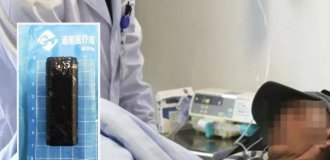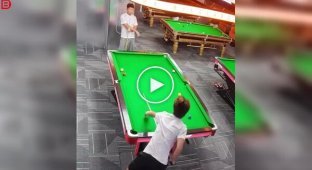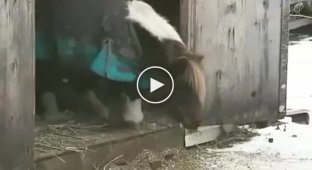In spite of those who did not believe ... Jean-Paul Belmondo (3 photos)
For the French audience, he replaced all the Hollywood supermen at once. Bebel, as the French lovingly called him, believed that he may not be a genius, but he tried to please people all his life... 
Going against the grain was typical of Belmondo's nature. When his father's good friend, the actor Andre Bruno, listened to Jean-Paul and, with all due respect to his parent, recognized the young man as catastrophically untalented, he, to spite Bruno, decided that he would become an actor.
A few years later, Pierre Dux, a teacher at the Conservatory of Dramatic Art, joked that if Jean-Paul, with his face, tried to play a lover, the audience would die laughing, and Belmondo then spent his whole life proving the opposite, and if directors begged him to take care of himself and not perform dangerous stunts without a stunt double, our hero took the risk with double the enthusiasm.
In his memoirs, the actor thanks his mother for never restricting his freedom, thanks to which he grew up an indomitable and unrestrained person. These qualities were aggravated by an excess of vital energy. Neither school, from which he was repeatedly expelled for terrible behavior, nor the army, nor strict directors could re-educate Belmondo.
In Paris, there is a street named after Jean-Paul's father. Paul Belmondo was a famous sculptor, in whose house celebrities and beautiful models often gathered. The young Belmondo was especially interested in the latter.
Not wanting to be a rich kid, Jean-Paul spent a lot of time in the back alleys, where in one of the many fights his nose was given its characteristic, flattened shape.
At the age of 15, he began boxing, excited by the victory of the Frenchman Marcel Sedan, nicknamed the Moroccan Bomber, over the American champion Tony Zale. At the age of 19, Jean-Paul won the Paris championship in the welterweight division, but soon left the sport for a more interesting occupation. 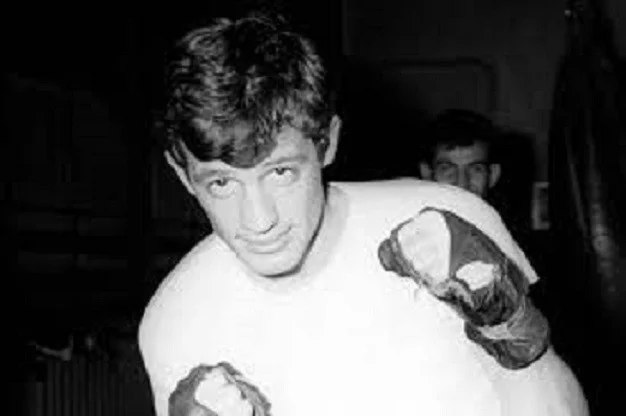
No matter what Andre Bruno said, Belmondo felt that he could act. He first caught this feeling in the mountains of Auvergne, where young Jean-Paul was sent to improve his health after doctors unexpectedly discovered that he had the early stages of tuberculosis. The restless Belmondo entertained people in a small "booth" at a local fair. Returning to the capital, of all the roads open to the son of a wealthy sculptor, he chose the least obvious - the path of an actor.
"Acting was my second nature," Belmondo explained. "I never had to make an effort to clown around and get into the skin of fictional characters."
Thanks to a good mentor, Raymond Girard, who was almost the only one who recognized the acting talent of the young Jean-Paul, Belmondo was able to gain experience and enter the Conservatory of Dramatic Art, the best theater school in France. He studied there as perhaps only Belmondo could: having suffered the mockery of teachers, he dropped out of the first year and enlisted in the army, where, having fallen asleep on guard duty, his nose was broken again.
After he quit, he entered the conservatory again, but soon dropped out – and again to the barracks.
When his theater studies got going, Belmondo was sent to the army for the third time – to the war in Algeria, where he was wounded in the leg. Then, in order to finally get discharged, he played a madman in front of the doctors, fortunately, he already had no shortage of acting skills. The play was a success, he was discharged.
Every young actor dreamed of getting into the Comédie Française, the country's main theater. Belmondo didn't get in, having received a low score for his graduation play, and the Comédie only accepted excellent students. The failure angered him, especially since the audience received the play with enthusiasm.
But who knows, would Belmondo have condescended to cinema, if he had ended up in a prestigious theater? And so, having wandered around for several years in private enterprises, and having spectacularly failed Medea in Jean Anouilh's production (playing a messenger bringing tragic news, Jean-Paul burst out laughing at the most inopportune moment), our hero accepted the offer of director Henri Esner to star in the film Sunday - We Will Steal, a screen version of a play in which he once played.
So, in the late 1950s, Belmondo gradually began to get involved in cinema, playing small roles here and there, until one day he was called out on the street by an impudent, lanky guy in dark glasses. It was Jean-Luc Godard...
Belmondo was an easy-going person, and this ease was the best fit for the mood of the films of Godard, Truffaut and Chabrol. And it is no coincidence that Belmondo played the main role in the best film of this wave - "Breathless" (1960) by Jean-Luc Godard. The hero of this innovatively fast-paced film flew through life at a breakneck speed, not thinking about the tragic circumstances that gradually took him into a deadly ring.
Belmondo found his first meeting with the director who made him famous all over the world very suspicious. Godard called him out on the street – unshaven, wearing dark glasses, smoking cigarette after cigarette. Speaking unbearably slowly and mysteriously quietly, the future film classic made a strange offer to the future movie star: “Come to my hotel, I’ll film you and pay you 50 thousand francs.”
After discussing the unusual meeting with his wife, Belmondo received some practical advice: “If he starts pestering you, you can easily punch him in the face.”
With such a reliable backup option in his pocket, Jean-Paul calmly went to Godard and immediately got into the short film “Charlotte and Her Jules.” There was no need to beat Godard: Belmondo was delighted with the director's manner of "directing without directing" - he gave the actors complete freedom, only slightly indicating the boundaries. That same day, Godard promised Jean-Paul the leading role in his future film and kept his word.
Belmondo managed to act in films with all the leading directors of the French "new wave". Even before the success of "Breathless", he played a charming rogue in Claude Chabrol's drama "The Double Turn of the Key" (1958), and then happily worked with Louis Malle in "The Thief" (1967) and François Truffaut in "The Mississippi Siren" (1969), where he played with Catherine Deneuve.
The critics did not like the last two films - Belmondo believed that they condemned him for deviating from the usual image of a regular guy.
The roles were indeed subtle, and in Truffaut's film Jean-Paul played an anti-macho - reflective, soft, unsuccessful - and was very proud of it.
As for Godard, who gave the actor a "start in life" and with whom he starred in three big films and one short film, for many years Belmondo considered Pierrot le Fou (1965) his favorite film, until, in his own words, he realized that there can be several favorite films. This strange, verbose and uncommercial film appeared after Belmondo persuaded Godard to film a book about the cruel bandit Jacques Mesrine. When filming began, Jean-Paul heard from the director: "The book is excellent, but we will film something completely different." And, knowing Godard well, Belmondo was no longer surprised...
The gloomy and stingy with praise Jean-Pierre Melville called Belmondo a gift to French cinema. He literally wore down Jean-Paul, who was basking in the rays of his first fame, by persuading him to play a priest in the film "Leon Morin, Priest" (1961). Belmondo, an atheist and a rake, did not see himself in this role, but Melville convinced him, and then cast the actor in two more films: "The Informer" (1962) and "The Elder Ferchot" (1963)
The collaboration ended after Belmondo, outraged by the director's poor treatment of an elderly actor on the set, gave Melville a good kick, tearing off his cowboy hat and dark glasses, which he never parted with. Melville was not offended and continued to regularly invite Jean-Paul to star in his films. The actor did not respond.
It was an honor to act for serious directors, but Belmondo was drawn to adventure films in which he could throw out all his energy and satisfy his passion for adventure.
He especially enjoyed filming in Philippe de Broca's "The Man from Rio" (1963) and Henri Verneuil's "One Hundred Thousand Dollars in the Sun" (1964) - the films that began his fame as a hero of popular cinema.
The craving for adrenaline-filled adventures led Belmondo to the idea of performing risky stunts himself. This is what he did all his life; Jean-Paul made his last dangerous foray at the age of 65, climbing a rope ladder from a convertible speeding down the highway to a helicopter flying overhead ("One Chance for Two").
They said that Belmondo worked without a stunt double in order to receive double the fee. Jean-Paul indignantly rejected such base motives. He did it for the sake of bravado, for self-affirmation, for the love of recklessness.
During one of his first stunts, he almost died. During the filming of "The Man from Rio" in Brasilia, Belmondo got stuck at the height of the 40th floor, crawling along a rope from one building to another, without any safety equipment. Thanks to his good physical training, Belmondo crawled to his destination, and the footage of the fatal stunt was included in the film.
This incident did not discourage Jean-Paul from taking risks. Nor did the death of his stuntman friend cool his ardor: Gilles Delamare crashed on a slippery road while doubling Jean Marais.
In "Ace of Aces," Belmondo stood up to his full height on a flying plane from the Second World War. In "Alone," he jumped from a helicopter onto a boat. He flew over cities many times on rope ladders, ropes, jumped on roofs, fell out of cars, and so on.
"Living to the fullest, without fear, without looking over your shoulder, because the road runs back too quickly - this became the general line of my existence," the actor wrote.
Surprisingly, Belmondo himself was rarely injured. While working on The Magnificent (1973) in Mexico, he broke his hip after jumping out of a car and landing off target. The problem was that the speed of the car for the stunt was calculated in European kilometers per hour, but while in the New World, actress Jacqueline Bisset thought it was miles and drove almost twice as fast.
The actor took such injuries for granted. He was much more upset by the injuries he inflicted on himself at home: once, Belmondo was impersonating Tarzan in front of children and fell to the floor along with the horizontal bar, knocking out his front teeth. He had to urgently fly to America for new teeth, and so that no one would suspect anything, Jean-Paul smoked a giant cigar the entire way.
Many actors hate sports and only get in shape the day before filming. Belmondo, however, had always trained furiously since his boxing youth, which did not stop him from partying no less furiously. He was overwhelmed with a thirst for activity, and wise directors understood that it was better to let Bebel let off steam on the set than to pay the bills for the destroyed hotels later. However, the actor had enough for both.
The description of the pranks with which Bebel and his friends entertained themselves during their student years and on the set takes up more space in his memoirs than his thoughts on cinema. For Belmondo, to act in a film and not have fun afterwards meant doing the job only halfway.
The screen workers put a lot of effort into destroying hotels. Not a very original occupation for celebrities. But Jean-Paul brought a touch of sporting competition to it. For example, who could throw furniture from one room to another through the window faster.
Surprisingly, some hotel owners, having recognized Bebel, did not demand compensation for damages and only politely asked: "I hope you had a good time?" The actor remembered them with particular warmth.
Belmondo was not the only ringleader. Director Philippe de Broca, with whom Jean-Paul made a dozen films, was also known as a considerable prankster. Belmondo preferred to act with the same troublemakers as himself.
But the patriarch of French cinema, Jean Gabin, with whom Belmondo starred in "A Monkey in Winter" (1962), did not share the mischievous mood. A respectable man, he was not averse to a drink and a snack, but he refused the subsequent races in Jean-Paul's sports car. On the contrary, after filming, he offered to give his young colleague a ride from Normandy to Paris and during this trip he drove the impetuous Belmondo to complete despair, because the leisurely patriarch drove no faster than 45 km/h the entire way.
After Pierre Dux's offensive words, hugging and kissing beauties in the movies became a matter of principle for Belmondo. Already in the first years, an impressive collection of film partners was formed - from Claudia Cardinale and Gina Lollobrigida to Jean Seberg and Anna Karina. When it came to Ursula Andress, the first Bond girl, with whom Jean-Paul played in "The Misadventures of a Chinaman in China" (1965), his marriage to the ballerina Elodie Constantin burst at the seams. Elodie had two daughters and a son with him. He parted with Elodie on good terms, but his affair with Andress was not fleeting either. They lived together for seven years, then Ursula was replaced by another beauty – Laura Antonelli, a star of Italian erotic cinema.
No matter how hard Belmondo tried, the nickname “ugly seducer” appeared in every second article about him. Not without pride, he quoted Edith Piaf: “I would have left with Delon, but I came back with Belmondo.”
The actor had many lovers, but his last affair turned out to be a fly in the ointment. The press openly called the former Playboy model Barbara Gandolfi, 43 years younger than Jean-Paul, a fraud, but the old artist stubbornly defended his passion, including during police interrogations. Belmondo had to admit the bitter truth, however, when after their breakup it was discovered that Gandolfi had laundered money through his accounts.
If in the 1960s Belmondo asserted himself and “searched for himself”, being eclectic in a good way, then in the next decade he found himself, and the range of roles narrowed. From then on, everything was built around the figure of an athletic, self-confident man, sometimes crazy, sometimes moderately gloomy. The time of interesting tandems with stars of equal magnitude - Ventura, Gabin - was over. In the films of the 1970s and 1980s, Belmondo was the center around which secondary characters fussily revolved.
And yet these were high-level films, because Belmondo continued to collaborate with the directors with whom he had worked together since the 1960s: with Henri Verneuil (Fear Over the City, The Corpse of My Enemy, The Adventurers), Jacques Deray (Outlaw, The Loner) and the old troublemaker Philippe de Broca (The Magnificent, The Incorrigible). In the 1970s, Georges Lautner was added to the list of Belmondo's regular companions, with whom Jean-Paul made the films Who's Who (1979), Four Hands (1980) and the most famous film of his heroic period, if not his most famous film ever, The Professional (1981), the story of a noble mercenary betrayed by his masters.
For many years, there was a competition between Belmondo and Alain Delon. They were almost the same age, and fame came to them at the same time. Critics and viewers constantly compared them, contrasted them, because they often starred in films by the same directors: Melville, Verneuil, Lautner. They were like ice and fire: the cold Delon and the expansive Bebel, the handsome man and the "ugly one", the introvert and the extrovert.
The actors admitted that there was competition between them, because both specialized in the images of cool loner heroes. It seems that Belmondo began acting in police films not least because Delon starred in them. Jean-Paul wanted to show that he would be good in this genre too.
They starred in the same film when they were still unknown to anyone - in secondary roles in "Be Beautiful and Shut Up" (1957) by Marc Allegret. Then, as young stars, they played in the war drama Is Paris Burning? (1965). "But there was no serious confrontation then," Belmondo stated.
And when things were going so well that each had their own film studio (Belmondo's was "Cherito", named after his grandmother), Delon and Belmondo came up with a project in which they could play on the cooperation of competitors. Borsalino (1970) repeated real events not only literally, but also figuratively: in it, they played two rival gangsters who became friends.
In reality, everything was not so smooth: Belmondo was angry with Delon for not fulfilling the agreement: on the poster, their names should be presented equally. Delon, being the producer of the project, doubled his presence, stating: "Alain Delon presents Delon and Belmondo in the new film." Jean-Paul did not approve of this, and the relationship between the two actors was covered with a crust of ice for many years.
In the 1990s, when both were already over 60, the rivals decided to forget old grievances. The public was increasingly interested in new stars, and in order to remind them of themselves, the veterans decided to join forces in the film "One Chance for Two" (1998). Their duet, decorated with the youth of Vanessa Paradis, was supposed to show the strength of old lions. But hopes were not justified: the film was not a success, and both lions were filled with bitterness about their place in the modern film industry.
Whether sincerely or disingenuously, Belmondo admitted that he was deprived of dramatic talent in the sense that gloomy tones, tragedy, etc. did not find a response in his cheerful soul. His nature demanded jubilation and victory, and if defeat, then without a shadow of despondency.
Most of Belmondo's film characters embody his own philosophy of life: be dynamic, enjoy life, do not think too much.
"I like to seem stupid. It's better than being a narcissistic smart guy," Belmondo repeated. Over time, he even began to exaggerate his anti-intellectualism, claiming that all his strength was in his fists, although even his most dashing characters did not suffer from feeblemindedness.
The simpleton that Jean-Paul pretended to be would hardly have spent years nurturing the idea of a film adaptation of Louis-Ferdinand Celine's "Journey to the End of the Night," and this was one of his obsessive desires that never came to fruition.
When the years began to take their toll and it became increasingly difficult for Belmondo to perform acrobatic somersaults, he returned to the theater, where he played the great tragic actor Kean and Cyrano de Bergerac in productions by Robert Hossein. And in the early 1990s, he bought the old Parisian theater "Varieties" and played in it.
For his role in "The Darling of Destiny" (1988) by Claude Lelouch, Belmondo was offered a "Cesar" - the main French film award. But the actor refused the award, explaining that the sculptor Cesar, who created the prize statuette, had once spoken badly of his father, Belmondo Sr.
Belmondo aged gracefully, but at 68 he suffered a severe stroke. He lost the right side of his body and speech. Then the actor showed that his image of a cheerful and unstoppable hero was not fiction. He recovered in record time, and a year later he was already sweating in the boxing gym, in spite of those who expected to see the "professional" faded and living out his days in a wheelchair.
Belmondo died on September 6, 2021, at the age of 89...
He liked to repeat that he lived a thousand lives instead of one, and that's what those who are more than happy with their fate say... 